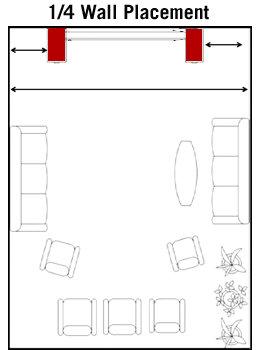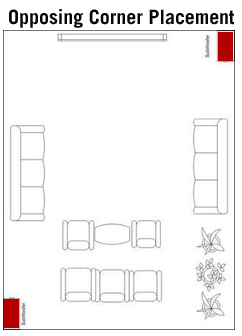If you’ve ever setup a subwoofer in your home theater system, chances are you’ve noticed that the bass sounds ripe ‘n rumble-y in some parts of the room, but not so good in others. This is due to your room’s acoustic properties and its tendency to reinforce or cancel specific bass frequencies depending on where your sub and listening positions are located in relation to the room and to each other. Carefully locating your seat and sub in the room can minimize this effect, but what if you have a dedicated theater room, or don’t watch movies alone?
In these cases, getting good bass becomes much more difficult. Since you can only optimize a subwoofer’s placement for a specific part of the room, a couple of well-placed listeners may get good bass, but the rest won’t. Even today’s advanced auto-calibration programs can’t do this accurately for multiple areas, and bass traps aren’t effective at the lowest frequencies (sub 50 Hz) unless they are impractically large. What’s a bass lover to do?
 The answer is: Get two subwoofers! That’s right: if you want the smoothest, most even bass across your whole room, having dual subwoofers is the way to go. That’s because two subs, placed at strategic locations in the room, will help to smooth out bass modes and nodes (i.e. peaks and dips) throughout the room for more even low frequency distribution. You’ll also notice improved low end extension and greater headroom, as well as more complete reproduction of the whole range of bass sounds for more a realistic, life-like experience. And if you already have a single sub, adding a second one to your system is super easy: Most of today’s better home theater receivers sport dual sub outs, or you can use a Y-connector to split your single output into two. Once you’ve got that settled, here’s what you need to know if you’re thinking about going the dual subwoofer route:
The answer is: Get two subwoofers! That’s right: if you want the smoothest, most even bass across your whole room, having dual subwoofers is the way to go. That’s because two subs, placed at strategic locations in the room, will help to smooth out bass modes and nodes (i.e. peaks and dips) throughout the room for more even low frequency distribution. You’ll also notice improved low end extension and greater headroom, as well as more complete reproduction of the whole range of bass sounds for more a realistic, life-like experience. And if you already have a single sub, adding a second one to your system is super easy: Most of today’s better home theater receivers sport dual sub outs, or you can use a Y-connector to split your single output into two. Once you’ve got that settled, here’s what you need to know if you’re thinking about going the dual subwoofer route:
- - - - - - - - - - - - - - - - - - - - - - - - - - - - - - - - - - - - - - - - - - - - - - - - - - - - - - - - - - - - - - - -
Consider Dual Subwoofers if you have:
- Multiple seating positions: While it’s possible to optimize the spatial relationship between your room, subwoofer, and one listening position, it’s near impossible to do this for several of them. Properly placed, two subs will provide smoother, more consistent bass coverage to all the listeners in the space.
- A dedicated theater room: For the same reasons as above, only to the nth degree—nothing can replicate the theater experience like two subwoofers can!
- Large overall space: Bass from a single sub tends to get lost in large spaces, so if you have a huge room or an open floor plan (i.e. no walls between the living room, kitchen, and/or hallways, etc.), two subs are almost a requirement for realistic bass quality and extension.
- A single, primary listening position but are jonesin’ for the smoothest bass response.
- - - - - - - - - - - - - - - - - - - - - - - - - - - - - - - - - - - - - - - - - - - - - - - - - - - - - - - - - - - - - - - -
Where to place the subs?
Ordinarily, we’d suggest the crawl method to snuff out the best location for your subwoofer, but that method only works for a single listening position: It’s mostly irrelevant for rooms with multiple seats and more than one sub. So then, how do you get two subs to produce great bass in your place?
Experimentation is the answer: Since there aren’t any guaranteed best spots when it comes to positioning multiple subwoofers, moving them around and listening for the changes is really the only way to get them locked-in with your lair. But if you have a rectangular room, you can use some general placement guidelines as starting points. Of course, your listening positions will also affect where in the room the subs sound their best. But once you’ve got that dialed in, check out some of the most popular dual subwoofer placement options below:

If you have a rectangular-shaped, dedicated theater room, multiple rows of seating, or just want excellent bass coverage, placing two subwoofers midway along the lengths of opposing sidewalls is the best recommendation. These locations yield the smoothest and most even bass distribution across the widest space due to something known as axial mode cancellation, thereby maximizing bass impact for the most listeners. You can also try placing your bass bins at opposing midwall points across the width if you can’t position them along the length.

No question, loading both subs in the front corners of the room provides the most bass. This is because doing so maximally excites all of the room’s resonances, thereby yielding more output for a given volume setting than ones that aren’t corner loaded. Moreover, you can lower the subs’ volume to increase headroom and decrease distortion. The downside is that corner placement can also provide too much reinforcement: Bass can sound boomy or uneven. If this happens, try bringing them out from the corners in small increments, starting with around one foot of space between each sub and each adjacent wall.

At this point you may be asking yourself, “Is it possible to get the best of both worlds, i.e. bass that’s a blend of both corner and midwall placement?” The answer is a definite maybe: Try positioning your subs along the front wall with their cone centers at the 1/4 and 3/4 distances of the room width. Rooms that are sympathetic with subs at these locations will yield almost as much bass output as corner placement but with a smoother overall frequency response. Of course, this reduces total output compared to full corner placement, but most quality subwoofers nowadays have more than enough headroom to compensate.

Unfortunately, we can’t always place our subs and our chairs in ideal parts of the room due to aesthetic or visual constraints: Many of us simply can’t remodel our room around these items, or have to deal with open floor plans, or irregularly shaped rooms, and the like. Luckily, there may still be a solution—opposite corner placement. Putting the subs in opposing front and back corners will maximally reinforce bass output like the front corners, but can also distribute more linear bass throughout the room. Try tweaking the subs’ positions little by little to see if there are sweet spots where the bass locks with the room. If you’re a bass freak, try this one even if you can do one of the placement options mentioned earlier: You may find this is your preferred bone-crunching, teeth-rattling option.
- - - - - - - - - - - - - - - - - - - - - - - - - - - - - - - - - - - - - - - - - - - - - - - - - - - - - - - - - - - - - - - -
Dialing in the Subwoofers:
After you’ve fine tuned your subs according to one of the above options, the last things to do are to tweak their volume levels, crossovers, and phase controls. To achieve proper phasing on your subs, play a steady test tone centered at your crossover frequency (i.e. 80Hz tone for same crossover setting) and have a friend vary the phase controls on each sub up and down until you hear the strongest tone; your subwoofer will now be in phase. All that’s left is to sit back, relax, and feel the good vibrations!
- - - - - - - - - - - - - - - - - - - - - - - - - - - - - - - - - - - - - - - - - - - - - - - - - - - - - - - - - - - - - - - -
Further Exploration:
Though the options listed above will get you well on your way to full sonic nirvana, they are far from exhaustive; If you’d like more in-depth information on bass/room interactions or just want to totally geek-out, check out the following links:
- Subwoofer Placement – The Place for Bass Part 1 – Great technical and scientific guide to the subwoofer/room interactions and thorough explanation of room modes and nodes.
- Home Theater Multiple Subwoofer Set-Up and Calibration Guide – In-Depth look at measuring and calibrating multiple subwoofers.
- Subwoofer Setup: How to get great bass in 3 steps - Thomas Norton from Sound & Vision provides his take on achieving great bass!
(Totally boss diagrams in this post courtesy Audioholics).











 https://www.aperionaudio.com
https://www.aperionaudio.com
1 comment
If you have two subwoofers, and one subwoofers about 15 feet and the other one is about 2 feet do you have to use the same length cable for both of them and if so, do you sell subwoofer cable single connection